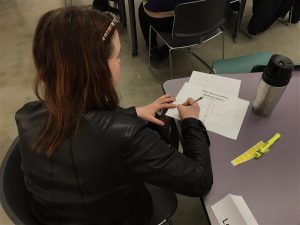On Friday March 16, the Junior Planning Students along with representatives from MARC held a charrette and presentation on Mobility Hubs associated with the Smart Moves 3.0 Plan. As a student in this class, my fellow students and I presented the information and data we have gathered on each of the mobility hubs. Among the attendees were various public officials associated with the mobility hubs that we randomly chose for our final project along with representatives from MARC and KCATA.

After the presentation, we invited attendees to participate in an information-gathering activity we dubbed “word salad.” The activity involved asking the participants to write down what Mobility Hubs and the future of autonomous vehicles meant to them. We then asked them to switch papers with another attendee and then highlight the words that stood out the most to them.

Next, we asked participants to follow a series of posters each representing different forms of transportation. On each poster, they were to mark which image of provided amenities was most important to enhance the individual transportation experience. This was done using a series of colored dots. Some participants even took the time to write additional amenities on the poster that weren’t available as a choice on the poster.

Finally, we invited our guests to move to the tables associated with each individual mobility hub assigned that represented the city or organization they were affiliated with. We gathered valuable input for development opportunities at our hubs as well as gain insight on the current ideas for the individual areas. Ideas and notes were represented and drawn using colorless development maps and and a box of crayons.

The information we gathered along with the experience itself were both invaluable to us as students learning about the profession. Some of the responses given for the various modes of transportation were surprising, and we discovered that both bike and bus-related amenities really matter to those involved. Unsurprisingly, as our group of attendees were all in the profession, not much emphasis was put on amenities for automobiles. Our guests also indicated a desire for making the pedestrian experience as aesthetically pleasing as possible through plantings, trees, lighting and street art. Finally, the activities showed us that the most important amenities to include in and around mobility hubs were those that involved eating, drinking and spending money, as the amenities most selected were cafes, grocery stores, bars and small retail.